Accounting Information Systems for Innovation: Examples of Cloud Computing and Blockchain
VerifiedAdded on 2023/06/07
|10
|3027
|470
AI Summary
This study evaluates the use of accounting information system for innovation by describing and analyzing practical examples of cloud computing and blockchain. It provides recommendations for businesses to make innovation in their operational activities through the application of an accounting information system.
Contribute Materials
Your contribution can guide someone’s learning journey. Share your
documents today.
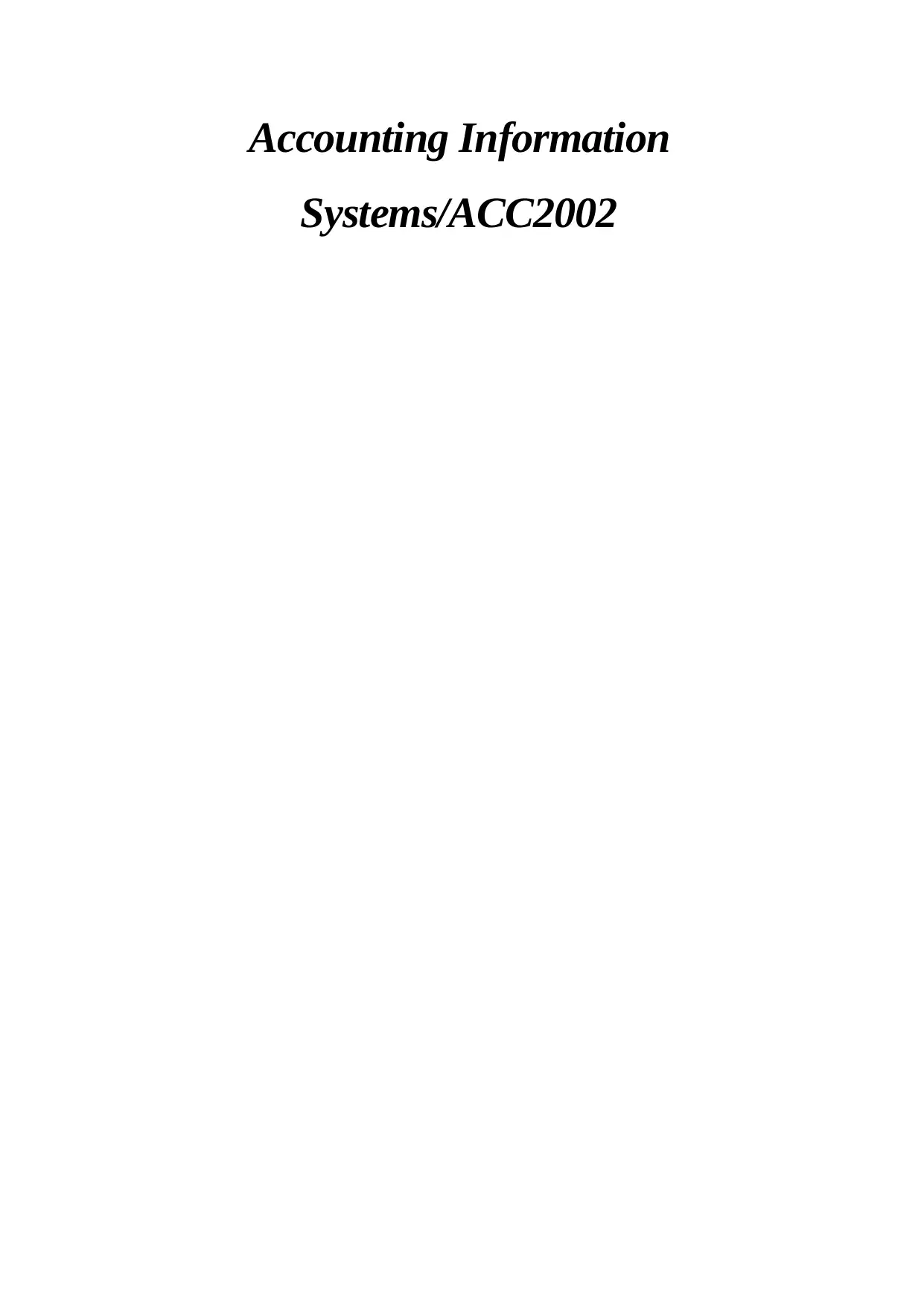
Accounting Information
Systems/ACC2002
Systems/ACC2002
Secure Best Marks with AI Grader
Need help grading? Try our AI Grader for instant feedback on your assignments.
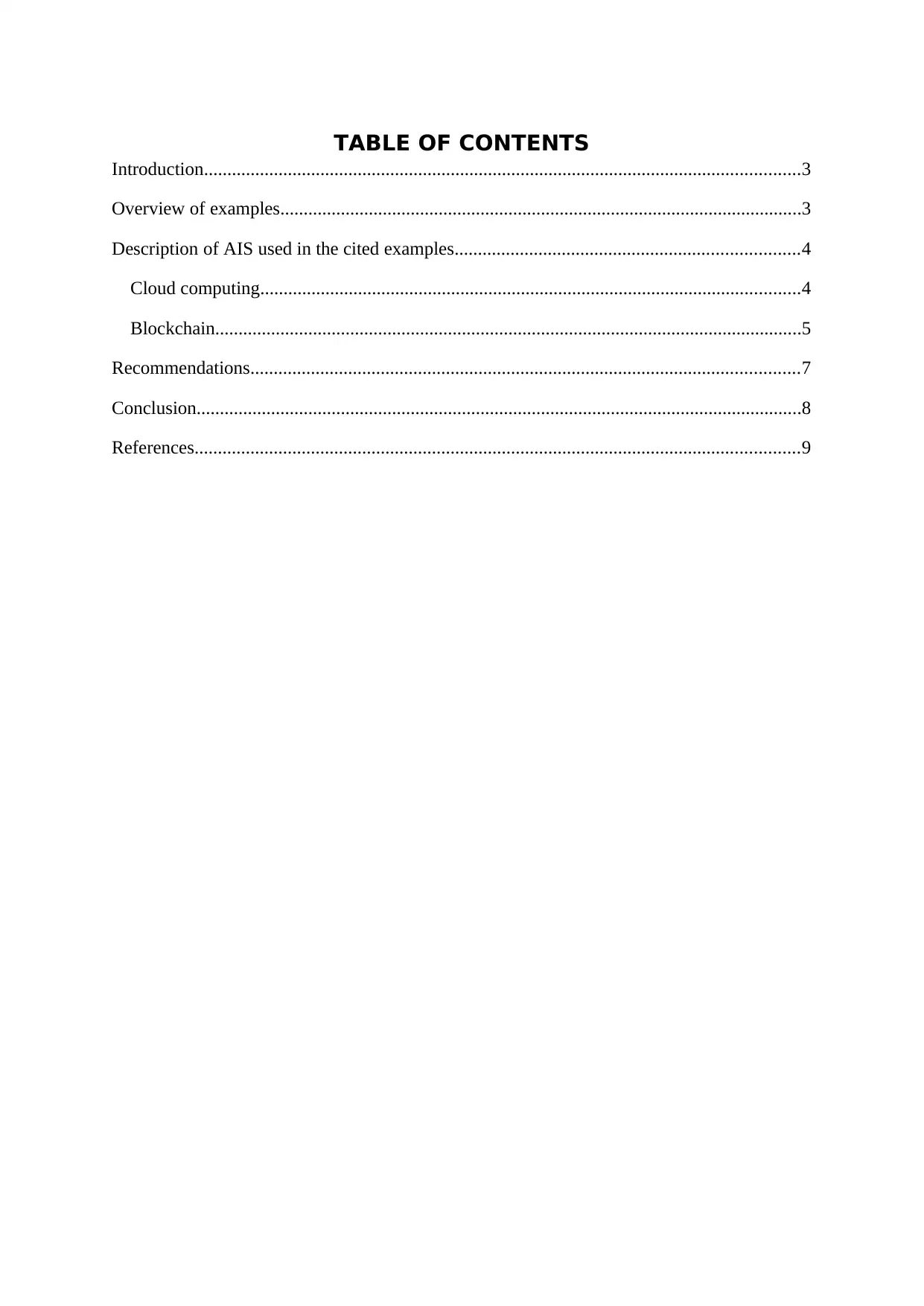
TABLE OF CONTENTS
Introduction................................................................................................................................3
Overview of examples................................................................................................................3
Description of AIS used in the cited examples..........................................................................4
Cloud computing....................................................................................................................4
Blockchain..............................................................................................................................5
Recommendations......................................................................................................................7
Conclusion..................................................................................................................................8
References..................................................................................................................................9
Introduction................................................................................................................................3
Overview of examples................................................................................................................3
Description of AIS used in the cited examples..........................................................................4
Cloud computing....................................................................................................................4
Blockchain..............................................................................................................................5
Recommendations......................................................................................................................7
Conclusion..................................................................................................................................8
References..................................................................................................................................9
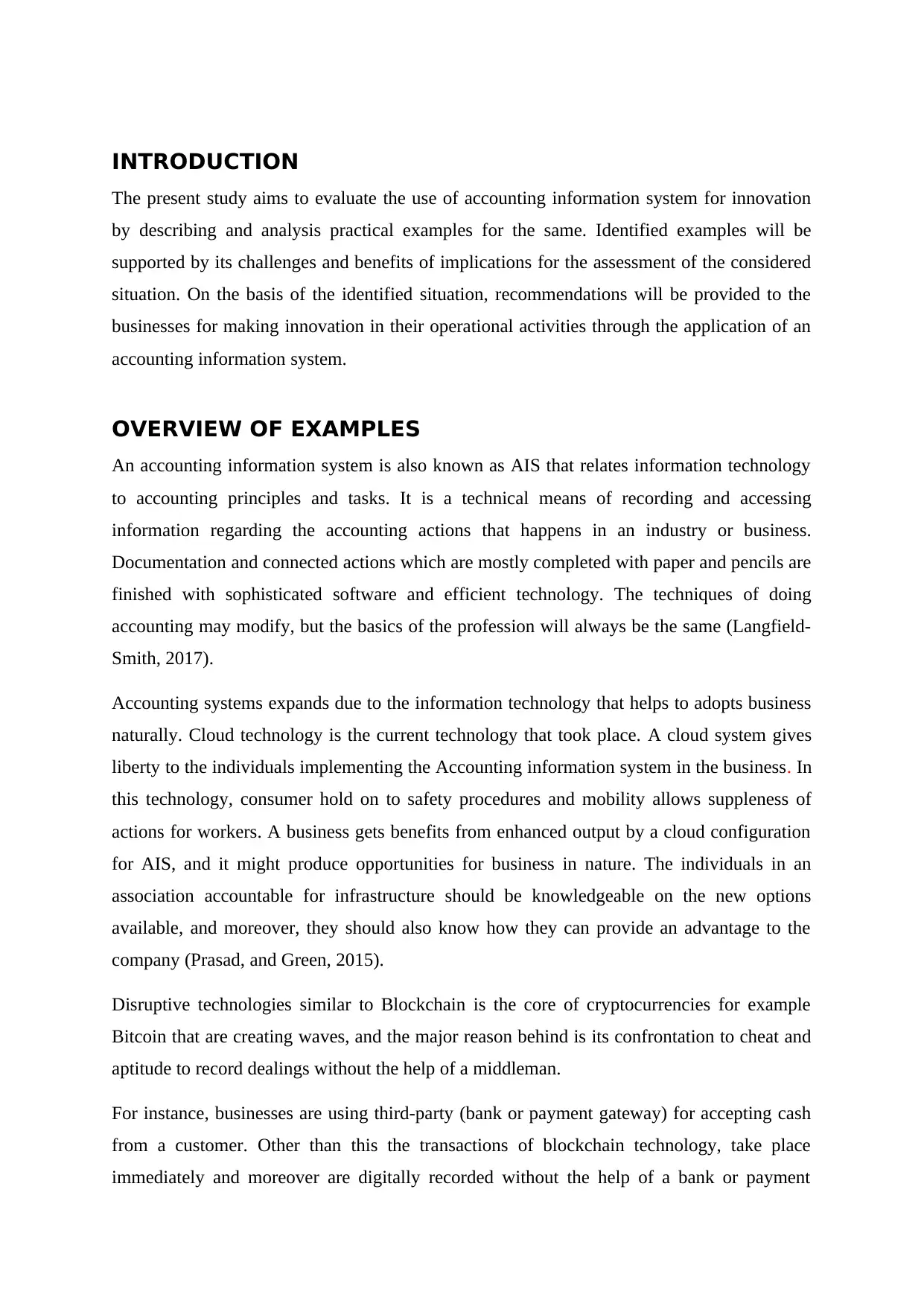
INTRODUCTION
The present study aims to evaluate the use of accounting information system for innovation
by describing and analysis practical examples for the same. Identified examples will be
supported by its challenges and benefits of implications for the assessment of the considered
situation. On the basis of the identified situation, recommendations will be provided to the
businesses for making innovation in their operational activities through the application of an
accounting information system.
OVERVIEW OF EXAMPLES
An accounting information system is also known as AIS that relates information technology
to accounting principles and tasks. It is a technical means of recording and accessing
information regarding the accounting actions that happens in an industry or business.
Documentation and connected actions which are mostly completed with paper and pencils are
finished with sophisticated software and efficient technology. The techniques of doing
accounting may modify, but the basics of the profession will always be the same (Langfield-
Smith, 2017).
Accounting systems expands due to the information technology that helps to adopts business
naturally. Cloud technology is the current technology that took place. A cloud system gives
liberty to the individuals implementing the Accounting information system in the business. In
this technology, consumer hold on to safety procedures and mobility allows suppleness of
actions for workers. A business gets benefits from enhanced output by a cloud configuration
for AIS, and it might produce opportunities for business in nature. The individuals in an
association accountable for infrastructure should be knowledgeable on the new options
available, and moreover, they should also know how they can provide an advantage to the
company (Prasad, and Green, 2015).
Disruptive technologies similar to Blockchain is the core of cryptocurrencies for example
Bitcoin that are creating waves, and the major reason behind is its confrontation to cheat and
aptitude to record dealings without the help of a middleman.
For instance, businesses are using third-party (bank or payment gateway) for accepting cash
from a customer. Other than this the transactions of blockchain technology, take place
immediately and moreover are digitally recorded without the help of a bank or payment
The present study aims to evaluate the use of accounting information system for innovation
by describing and analysis practical examples for the same. Identified examples will be
supported by its challenges and benefits of implications for the assessment of the considered
situation. On the basis of the identified situation, recommendations will be provided to the
businesses for making innovation in their operational activities through the application of an
accounting information system.
OVERVIEW OF EXAMPLES
An accounting information system is also known as AIS that relates information technology
to accounting principles and tasks. It is a technical means of recording and accessing
information regarding the accounting actions that happens in an industry or business.
Documentation and connected actions which are mostly completed with paper and pencils are
finished with sophisticated software and efficient technology. The techniques of doing
accounting may modify, but the basics of the profession will always be the same (Langfield-
Smith, 2017).
Accounting systems expands due to the information technology that helps to adopts business
naturally. Cloud technology is the current technology that took place. A cloud system gives
liberty to the individuals implementing the Accounting information system in the business. In
this technology, consumer hold on to safety procedures and mobility allows suppleness of
actions for workers. A business gets benefits from enhanced output by a cloud configuration
for AIS, and it might produce opportunities for business in nature. The individuals in an
association accountable for infrastructure should be knowledgeable on the new options
available, and moreover, they should also know how they can provide an advantage to the
company (Prasad, and Green, 2015).
Disruptive technologies similar to Blockchain is the core of cryptocurrencies for example
Bitcoin that are creating waves, and the major reason behind is its confrontation to cheat and
aptitude to record dealings without the help of a middleman.
For instance, businesses are using third-party (bank or payment gateway) for accepting cash
from a customer. Other than this the transactions of blockchain technology, take place
immediately and moreover are digitally recorded without the help of a bank or payment

processor (Laudon and Laudon, 2016). In accounting, blockchain technology knows how to
mechanize auditing and make the happing of the deception nearly unfeasible (Botta 2017).
DESCRIPTION OF AIS USED IN THE CITED EXAMPLES
Cloud computing
Cloud systems services are provided for the decisions with the observance of an AIS
functioning throughout the cloud. One of the decisions is known as Software-as-a-Service
(SaaS). Furthermore, with such a solution, a company acquires the usage of a cloud-based
accounting software system. The sources uphold liability for the preservation of the software
and the hardware (Rittinghouse, and Ransome, 2016). The organization can buy AIS by
considering such aspects; otherwise, the companies may decide to buy the use of an ERP
system on the whole. On the other hand, a business may make use of Platform-as-a-Service
cloud technology. In such a situation, the supplier upholds accountability for the
infrastructure, and furthermore, the business preserves the software put in on the platform
(Hashem, 2015).
However, the shift to cloud computing demands technology; it creates an impact on both the
external and internal basis that means on the organization, human resources, and customers,
technical and environmental factors. For this, the business is required to consider everything
from scratch from their managerial skills to the openness to the new environment. Since
transitions are really delicate, so it is essential to ensure and handle aspects with caution to
the cloud platform and computing (Almorsy, Grundy and Müller, 2016). The cloud adoption
shows a shift in the norms of the organization and its environment and culture too. The
impacts come in the form of security and legal issues confidentially of data and data
jurisdictions. The business can be impacted by the security issues that can embrace the
requirement for the self-awareness of the regulatory authorities and work environment.
However, some of the factors have an affirmative impact on the implementation of the cloud
computing which are complexities, technological readiness and competitive force (Etro,
2015). The external factors, as well as internal factors by the use of cloud computing, can be
affected in terms of service availability, data locking, data secrecy, performance
unpredictability, scalable space and software licensing. There are several challenges related
to the adoption of cloud computing in technological aspects which can be integration,
mechanize auditing and make the happing of the deception nearly unfeasible (Botta 2017).
DESCRIPTION OF AIS USED IN THE CITED EXAMPLES
Cloud computing
Cloud systems services are provided for the decisions with the observance of an AIS
functioning throughout the cloud. One of the decisions is known as Software-as-a-Service
(SaaS). Furthermore, with such a solution, a company acquires the usage of a cloud-based
accounting software system. The sources uphold liability for the preservation of the software
and the hardware (Rittinghouse, and Ransome, 2016). The organization can buy AIS by
considering such aspects; otherwise, the companies may decide to buy the use of an ERP
system on the whole. On the other hand, a business may make use of Platform-as-a-Service
cloud technology. In such a situation, the supplier upholds accountability for the
infrastructure, and furthermore, the business preserves the software put in on the platform
(Hashem, 2015).
However, the shift to cloud computing demands technology; it creates an impact on both the
external and internal basis that means on the organization, human resources, and customers,
technical and environmental factors. For this, the business is required to consider everything
from scratch from their managerial skills to the openness to the new environment. Since
transitions are really delicate, so it is essential to ensure and handle aspects with caution to
the cloud platform and computing (Almorsy, Grundy and Müller, 2016). The cloud adoption
shows a shift in the norms of the organization and its environment and culture too. The
impacts come in the form of security and legal issues confidentially of data and data
jurisdictions. The business can be impacted by the security issues that can embrace the
requirement for the self-awareness of the regulatory authorities and work environment.
However, some of the factors have an affirmative impact on the implementation of the cloud
computing which are complexities, technological readiness and competitive force (Etro,
2015). The external factors, as well as internal factors by the use of cloud computing, can be
affected in terms of service availability, data locking, data secrecy, performance
unpredictability, scalable space and software licensing. There are several challenges related
to the adoption of cloud computing in technological aspects which can be integration,
Secure Best Marks with AI Grader
Need help grading? Try our AI Grader for instant feedback on your assignments.
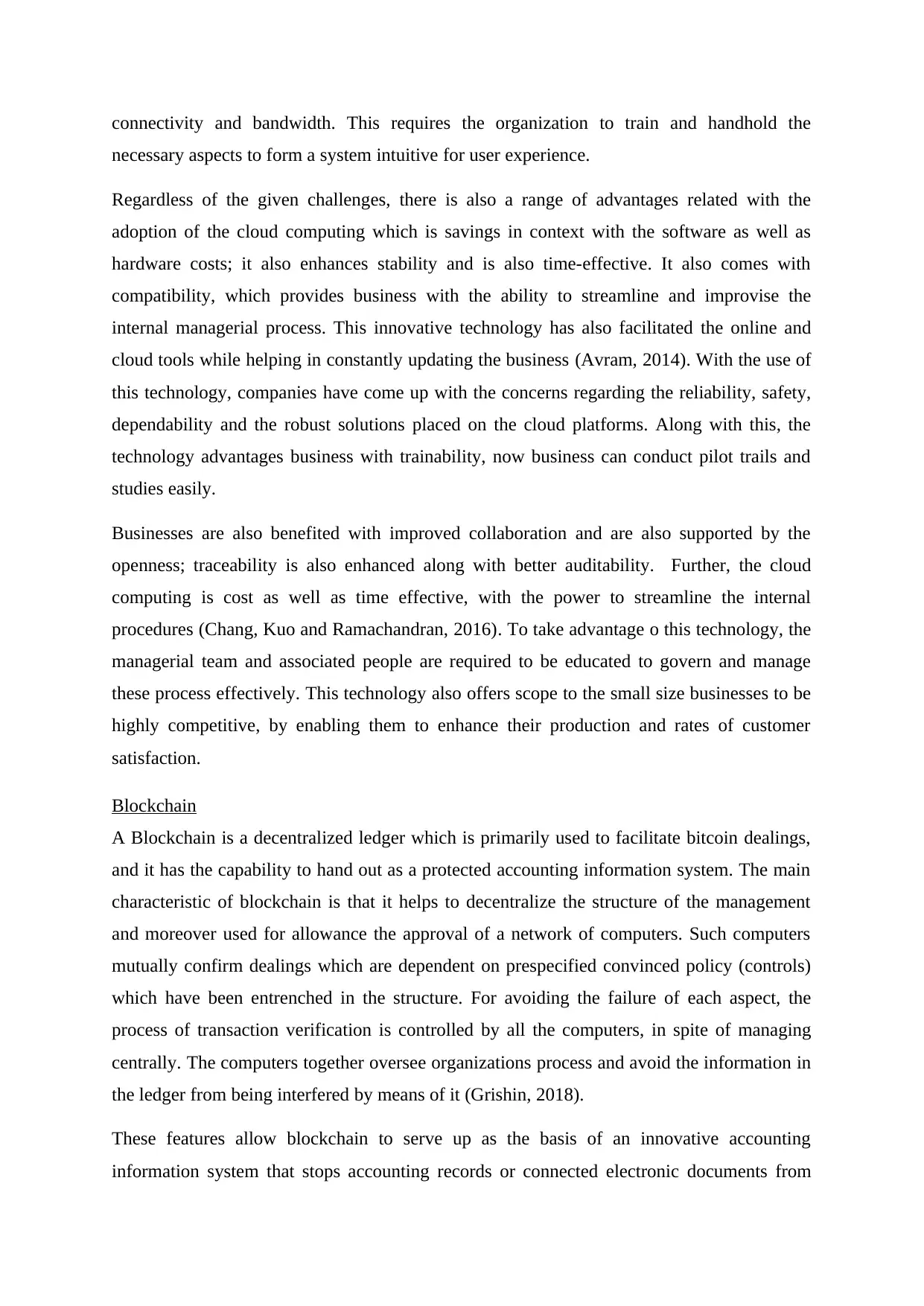
connectivity and bandwidth. This requires the organization to train and handhold the
necessary aspects to form a system intuitive for user experience.
Regardless of the given challenges, there is also a range of advantages related with the
adoption of the cloud computing which is savings in context with the software as well as
hardware costs; it also enhances stability and is also time-effective. It also comes with
compatibility, which provides business with the ability to streamline and improvise the
internal managerial process. This innovative technology has also facilitated the online and
cloud tools while helping in constantly updating the business (Avram, 2014). With the use of
this technology, companies have come up with the concerns regarding the reliability, safety,
dependability and the robust solutions placed on the cloud platforms. Along with this, the
technology advantages business with trainability, now business can conduct pilot trails and
studies easily.
Businesses are also benefited with improved collaboration and are also supported by the
openness; traceability is also enhanced along with better auditability. Further, the cloud
computing is cost as well as time effective, with the power to streamline the internal
procedures (Chang, Kuo and Ramachandran, 2016). To take advantage o this technology, the
managerial team and associated people are required to be educated to govern and manage
these process effectively. This technology also offers scope to the small size businesses to be
highly competitive, by enabling them to enhance their production and rates of customer
satisfaction.
Blockchain
A Blockchain is a decentralized ledger which is primarily used to facilitate bitcoin dealings,
and it has the capability to hand out as a protected accounting information system. The main
characteristic of blockchain is that it helps to decentralize the structure of the management
and moreover used for allowance the approval of a network of computers. Such computers
mutually confirm dealings which are dependent on prespecified convinced policy (controls)
which have been entrenched in the structure. For avoiding the failure of each aspect, the
process of transaction verification is controlled by all the computers, in spite of managing
centrally. The computers together oversee organizations process and avoid the information in
the ledger from being interfered by means of it (Grishin, 2018).
These features allow blockchain to serve up as the basis of an innovative accounting
information system that stops accounting records or connected electronic documents from
necessary aspects to form a system intuitive for user experience.
Regardless of the given challenges, there is also a range of advantages related with the
adoption of the cloud computing which is savings in context with the software as well as
hardware costs; it also enhances stability and is also time-effective. It also comes with
compatibility, which provides business with the ability to streamline and improvise the
internal managerial process. This innovative technology has also facilitated the online and
cloud tools while helping in constantly updating the business (Avram, 2014). With the use of
this technology, companies have come up with the concerns regarding the reliability, safety,
dependability and the robust solutions placed on the cloud platforms. Along with this, the
technology advantages business with trainability, now business can conduct pilot trails and
studies easily.
Businesses are also benefited with improved collaboration and are also supported by the
openness; traceability is also enhanced along with better auditability. Further, the cloud
computing is cost as well as time effective, with the power to streamline the internal
procedures (Chang, Kuo and Ramachandran, 2016). To take advantage o this technology, the
managerial team and associated people are required to be educated to govern and manage
these process effectively. This technology also offers scope to the small size businesses to be
highly competitive, by enabling them to enhance their production and rates of customer
satisfaction.
Blockchain
A Blockchain is a decentralized ledger which is primarily used to facilitate bitcoin dealings,
and it has the capability to hand out as a protected accounting information system. The main
characteristic of blockchain is that it helps to decentralize the structure of the management
and moreover used for allowance the approval of a network of computers. Such computers
mutually confirm dealings which are dependent on prespecified convinced policy (controls)
which have been entrenched in the structure. For avoiding the failure of each aspect, the
process of transaction verification is controlled by all the computers, in spite of managing
centrally. The computers together oversee organizations process and avoid the information in
the ledger from being interfered by means of it (Grishin, 2018).
These features allow blockchain to serve up as the basis of an innovative accounting
information system that stops accounting records or connected electronic documents from

being distorted or erased. Additionally, sharing accounting facts with several associates (for
example business partners, investors, executives, and assessor) let all of them contribute in
performing an independent test of dealings and bringing immediate pledge (Swan, 2015).
Banking institutions, communication companies and conventional media are the major targets
of the blockchain technology, it is said that replacing just a proportion of these areas with a
blockchain system can drastically impact as a whole by causing an immense disruption, but
also by adding an immense increase in the rate of efficiencies (Schaupp and Festa, 2018). The
impacts of the blockchain technology are apparently obvious, with an ever-extending network
and the growing platform the blockchain technology offers new means for the conventional
middleman and company rivals to take betters steps into the competitive markets(Batubara,
Ubacht and Janssen, 2018). Additionally, this technology has also impacted individuals in the
manner they made payments and money transfers, do voting networking, sales, stock trading,
insurance and real estate. In technical terms, a blockchain technology enables a ledger by
making use of a backend database, and in legal terms, it can validate the contracts, also in the
absence of the people.
A recycling program that makes use of blockchain technology can motivate the participation
by issuing rewards and points to the users to decrease environmental impacts. Blockchain
technology can help in increasing the compliance with environmental treaties by the data
transparency. Blockchain technology offers scope for the business efficiencies as much as
possible, while also creating a transparent culture. Most of the monitoring related costs can be
dramatically decreased, if not entirely alleviated; by making use of this technology, trust can
be established amid shareholders and directors (Casey and et al., 2018). The increased trust
among these parties can reduce stress and the related costs with the diligence procedure.
Blockchain offers and documents transactions in a manner that adds transparency security
and resistance to change, auditability and efficiency. Along with this, the blockchain is a
means by which the environment is protected, as it is highly accessible to various users, and
there is transparency in the obtained data which cannot be altered and when added cannot be
eliminated, it takes the validation of the several computers before there is integration of new
record. This makes a reduction in the transactional costs, adding to this improvised
efficiency. The innovative technology of blockchain also cheers up the peer-to-peer
transaction, and can also be integrated to trace products and help in preventing wastage,
ineffectiveness, misleading practices, fraud through adding transparency in supply chain
management (Iansiti and Lakhani, 2017). They can also assist the customers to get informed
example business partners, investors, executives, and assessor) let all of them contribute in
performing an independent test of dealings and bringing immediate pledge (Swan, 2015).
Banking institutions, communication companies and conventional media are the major targets
of the blockchain technology, it is said that replacing just a proportion of these areas with a
blockchain system can drastically impact as a whole by causing an immense disruption, but
also by adding an immense increase in the rate of efficiencies (Schaupp and Festa, 2018). The
impacts of the blockchain technology are apparently obvious, with an ever-extending network
and the growing platform the blockchain technology offers new means for the conventional
middleman and company rivals to take betters steps into the competitive markets(Batubara,
Ubacht and Janssen, 2018). Additionally, this technology has also impacted individuals in the
manner they made payments and money transfers, do voting networking, sales, stock trading,
insurance and real estate. In technical terms, a blockchain technology enables a ledger by
making use of a backend database, and in legal terms, it can validate the contracts, also in the
absence of the people.
A recycling program that makes use of blockchain technology can motivate the participation
by issuing rewards and points to the users to decrease environmental impacts. Blockchain
technology can help in increasing the compliance with environmental treaties by the data
transparency. Blockchain technology offers scope for the business efficiencies as much as
possible, while also creating a transparent culture. Most of the monitoring related costs can be
dramatically decreased, if not entirely alleviated; by making use of this technology, trust can
be established amid shareholders and directors (Casey and et al., 2018). The increased trust
among these parties can reduce stress and the related costs with the diligence procedure.
Blockchain offers and documents transactions in a manner that adds transparency security
and resistance to change, auditability and efficiency. Along with this, the blockchain is a
means by which the environment is protected, as it is highly accessible to various users, and
there is transparency in the obtained data which cannot be altered and when added cannot be
eliminated, it takes the validation of the several computers before there is integration of new
record. This makes a reduction in the transactional costs, adding to this improvised
efficiency. The innovative technology of blockchain also cheers up the peer-to-peer
transaction, and can also be integrated to trace products and help in preventing wastage,
ineffectiveness, misleading practices, fraud through adding transparency in supply chain
management (Iansiti and Lakhani, 2017). They can also assist the customers to get informed
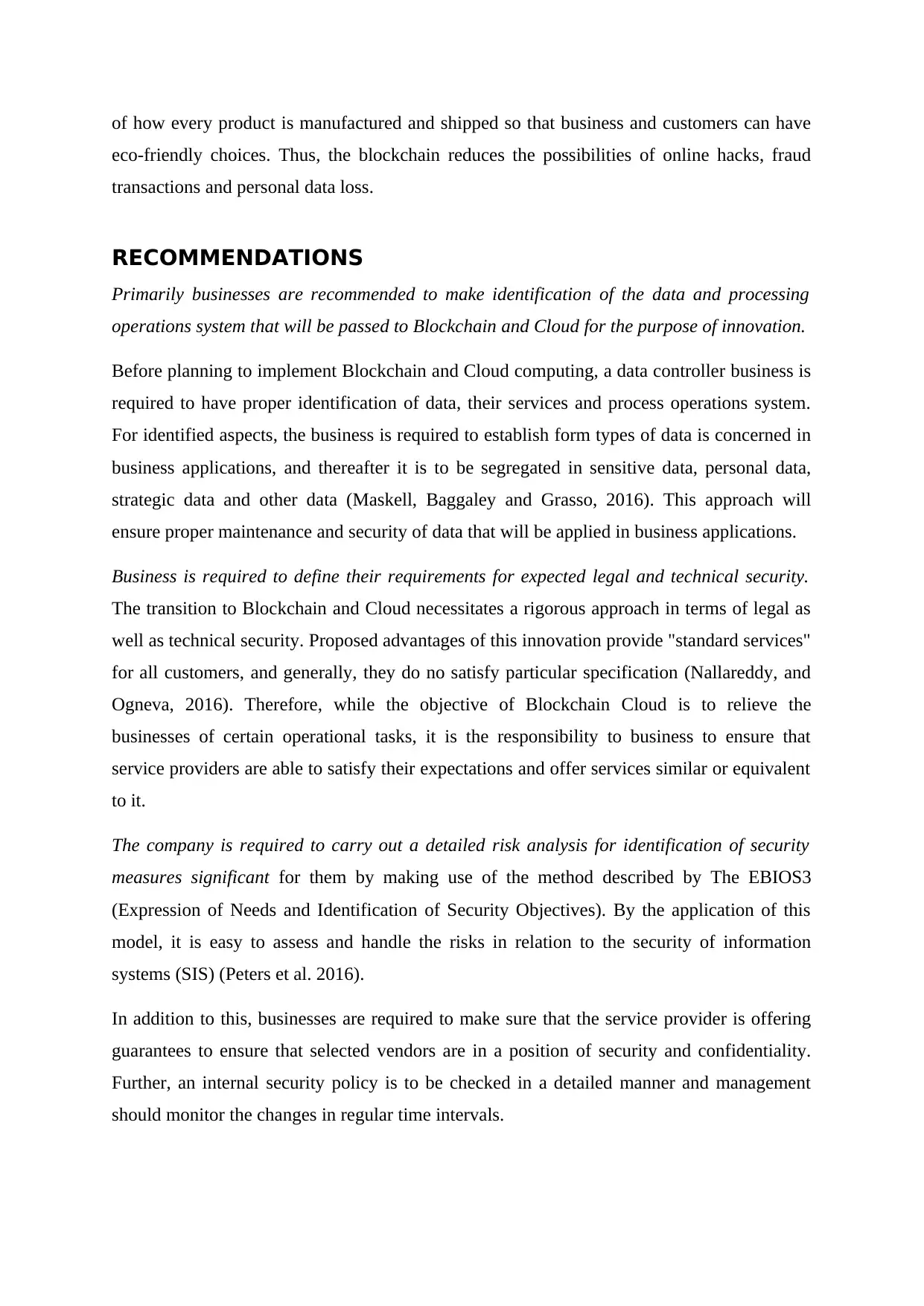
of how every product is manufactured and shipped so that business and customers can have
eco-friendly choices. Thus, the blockchain reduces the possibilities of online hacks, fraud
transactions and personal data loss.
RECOMMENDATIONS
Primarily businesses are recommended to make identification of the data and processing
operations system that will be passed to Blockchain and Cloud for the purpose of innovation.
Before planning to implement Blockchain and Cloud computing, a data controller business is
required to have proper identification of data, their services and process operations system.
For identified aspects, the business is required to establish form types of data is concerned in
business applications, and thereafter it is to be segregated in sensitive data, personal data,
strategic data and other data (Maskell, Baggaley and Grasso, 2016). This approach will
ensure proper maintenance and security of data that will be applied in business applications.
Business is required to define their requirements for expected legal and technical security.
The transition to Blockchain and Cloud necessitates a rigorous approach in terms of legal as
well as technical security. Proposed advantages of this innovation provide "standard services"
for all customers, and generally, they do no satisfy particular specification (Nallareddy, and
Ogneva, 2016). Therefore, while the objective of Blockchain Cloud is to relieve the
businesses of certain operational tasks, it is the responsibility to business to ensure that
service providers are able to satisfy their expectations and offer services similar or equivalent
to it.
The company is required to carry out a detailed risk analysis for identification of security
measures significant for them by making use of the method described by The EBIOS3
(Expression of Needs and Identification of Security Objectives). By the application of this
model, it is easy to assess and handle the risks in relation to the security of information
systems (SIS) (Peters et al. 2016).
In addition to this, businesses are required to make sure that the service provider is offering
guarantees to ensure that selected vendors are in a position of security and confidentiality.
Further, an internal security policy is to be checked in a detailed manner and management
should monitor the changes in regular time intervals.
eco-friendly choices. Thus, the blockchain reduces the possibilities of online hacks, fraud
transactions and personal data loss.
RECOMMENDATIONS
Primarily businesses are recommended to make identification of the data and processing
operations system that will be passed to Blockchain and Cloud for the purpose of innovation.
Before planning to implement Blockchain and Cloud computing, a data controller business is
required to have proper identification of data, their services and process operations system.
For identified aspects, the business is required to establish form types of data is concerned in
business applications, and thereafter it is to be segregated in sensitive data, personal data,
strategic data and other data (Maskell, Baggaley and Grasso, 2016). This approach will
ensure proper maintenance and security of data that will be applied in business applications.
Business is required to define their requirements for expected legal and technical security.
The transition to Blockchain and Cloud necessitates a rigorous approach in terms of legal as
well as technical security. Proposed advantages of this innovation provide "standard services"
for all customers, and generally, they do no satisfy particular specification (Nallareddy, and
Ogneva, 2016). Therefore, while the objective of Blockchain Cloud is to relieve the
businesses of certain operational tasks, it is the responsibility to business to ensure that
service providers are able to satisfy their expectations and offer services similar or equivalent
to it.
The company is required to carry out a detailed risk analysis for identification of security
measures significant for them by making use of the method described by The EBIOS3
(Expression of Needs and Identification of Security Objectives). By the application of this
model, it is easy to assess and handle the risks in relation to the security of information
systems (SIS) (Peters et al. 2016).
In addition to this, businesses are required to make sure that the service provider is offering
guarantees to ensure that selected vendors are in a position of security and confidentiality.
Further, an internal security policy is to be checked in a detailed manner and management
should monitor the changes in regular time intervals.
Paraphrase This Document
Need a fresh take? Get an instant paraphrase of this document with our AI Paraphraser
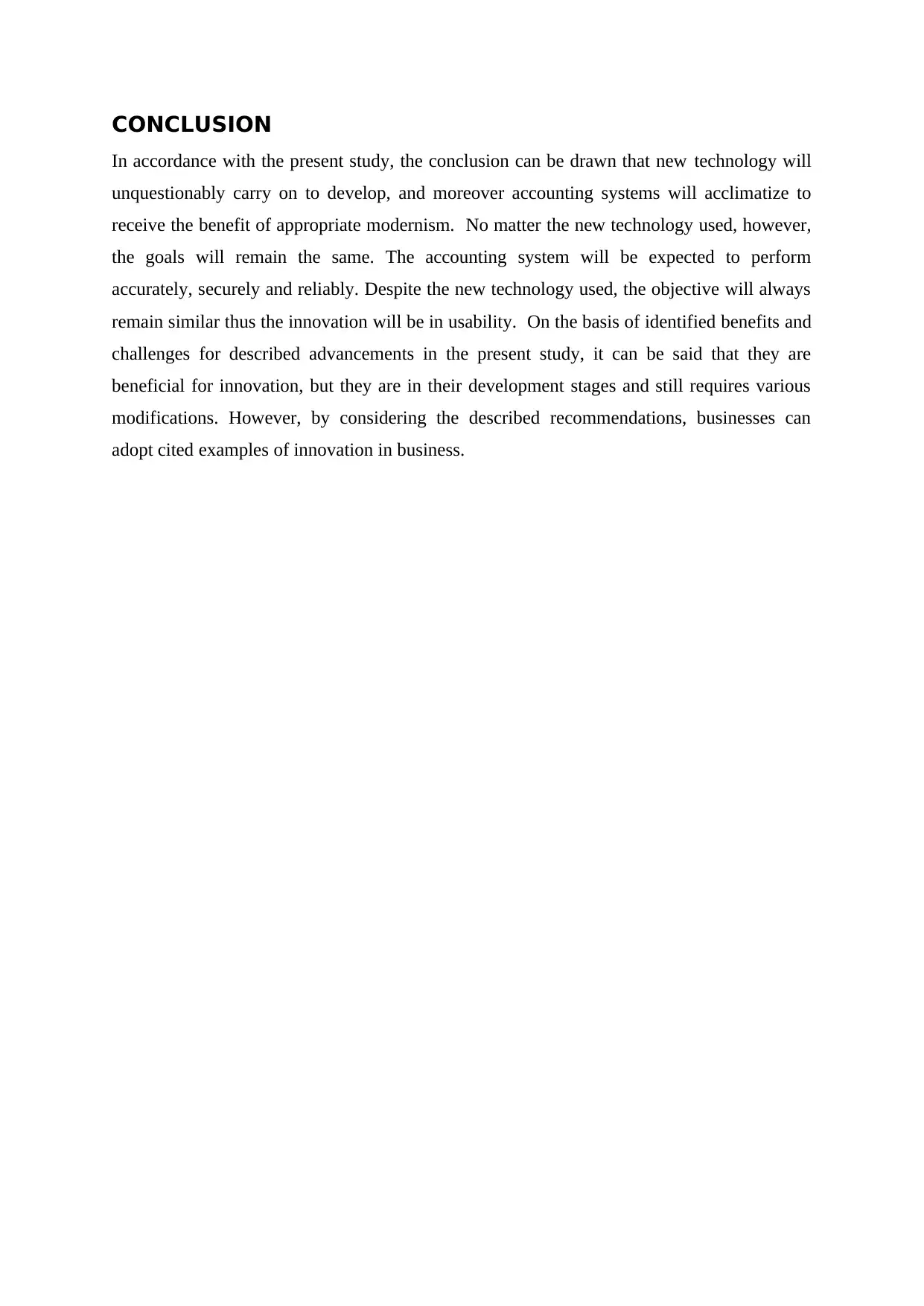
CONCLUSION
In accordance with the present study, the conclusion can be drawn that new technology will
unquestionably carry on to develop, and moreover accounting systems will acclimatize to
receive the benefit of appropriate modernism. No matter the new technology used, however,
the goals will remain the same. The accounting system will be expected to perform
accurately, securely and reliably. Despite the new technology used, the objective will always
remain similar thus the innovation will be in usability. On the basis of identified benefits and
challenges for described advancements in the present study, it can be said that they are
beneficial for innovation, but they are in their development stages and still requires various
modifications. However, by considering the described recommendations, businesses can
adopt cited examples of innovation in business.
In accordance with the present study, the conclusion can be drawn that new technology will
unquestionably carry on to develop, and moreover accounting systems will acclimatize to
receive the benefit of appropriate modernism. No matter the new technology used, however,
the goals will remain the same. The accounting system will be expected to perform
accurately, securely and reliably. Despite the new technology used, the objective will always
remain similar thus the innovation will be in usability. On the basis of identified benefits and
challenges for described advancements in the present study, it can be said that they are
beneficial for innovation, but they are in their development stages and still requires various
modifications. However, by considering the described recommendations, businesses can
adopt cited examples of innovation in business.
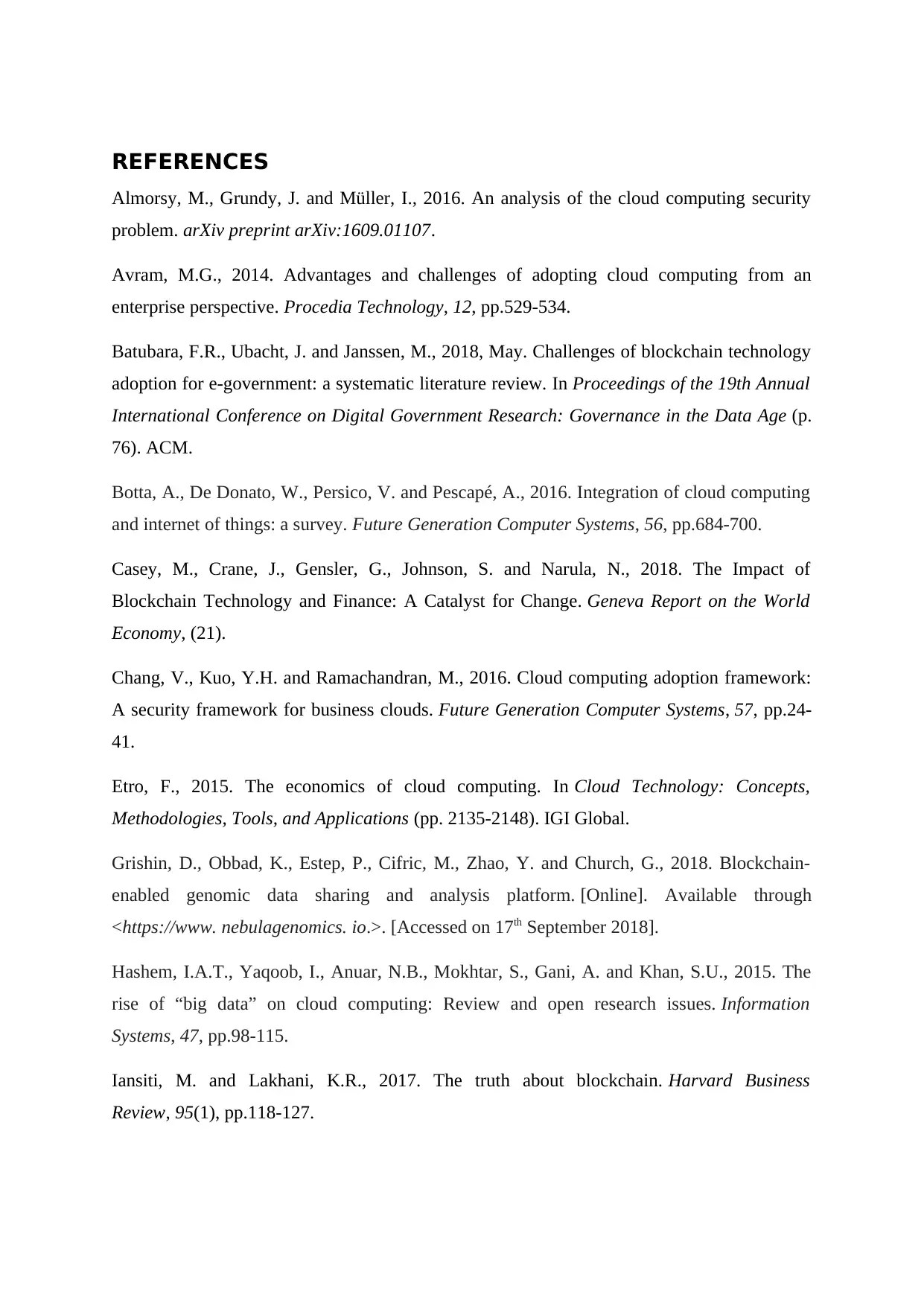
REFERENCES
Almorsy, M., Grundy, J. and Müller, I., 2016. An analysis of the cloud computing security
problem. arXiv preprint arXiv:1609.01107.
Avram, M.G., 2014. Advantages and challenges of adopting cloud computing from an
enterprise perspective. Procedia Technology, 12, pp.529-534.
Batubara, F.R., Ubacht, J. and Janssen, M., 2018, May. Challenges of blockchain technology
adoption for e-government: a systematic literature review. In Proceedings of the 19th Annual
International Conference on Digital Government Research: Governance in the Data Age (p.
76). ACM.
Botta, A., De Donato, W., Persico, V. and Pescapé, A., 2016. Integration of cloud computing
and internet of things: a survey. Future Generation Computer Systems, 56, pp.684-700.
Casey, M., Crane, J., Gensler, G., Johnson, S. and Narula, N., 2018. The Impact of
Blockchain Technology and Finance: A Catalyst for Change. Geneva Report on the World
Economy, (21).
Chang, V., Kuo, Y.H. and Ramachandran, M., 2016. Cloud computing adoption framework:
A security framework for business clouds. Future Generation Computer Systems, 57, pp.24-
41.
Etro, F., 2015. The economics of cloud computing. In Cloud Technology: Concepts,
Methodologies, Tools, and Applications (pp. 2135-2148). IGI Global.
Grishin, D., Obbad, K., Estep, P., Cifric, M., Zhao, Y. and Church, G., 2018. Blockchain-
enabled genomic data sharing and analysis platform. [Online]. Available through
<https://www. nebulagenomics. io.>. [Accessed on 17th September 2018].
Hashem, I.A.T., Yaqoob, I., Anuar, N.B., Mokhtar, S., Gani, A. and Khan, S.U., 2015. The
rise of “big data” on cloud computing: Review and open research issues. Information
Systems, 47, pp.98-115.
Iansiti, M. and Lakhani, K.R., 2017. The truth about blockchain. Harvard Business
Review, 95(1), pp.118-127.
Almorsy, M., Grundy, J. and Müller, I., 2016. An analysis of the cloud computing security
problem. arXiv preprint arXiv:1609.01107.
Avram, M.G., 2014. Advantages and challenges of adopting cloud computing from an
enterprise perspective. Procedia Technology, 12, pp.529-534.
Batubara, F.R., Ubacht, J. and Janssen, M., 2018, May. Challenges of blockchain technology
adoption for e-government: a systematic literature review. In Proceedings of the 19th Annual
International Conference on Digital Government Research: Governance in the Data Age (p.
76). ACM.
Botta, A., De Donato, W., Persico, V. and Pescapé, A., 2016. Integration of cloud computing
and internet of things: a survey. Future Generation Computer Systems, 56, pp.684-700.
Casey, M., Crane, J., Gensler, G., Johnson, S. and Narula, N., 2018. The Impact of
Blockchain Technology and Finance: A Catalyst for Change. Geneva Report on the World
Economy, (21).
Chang, V., Kuo, Y.H. and Ramachandran, M., 2016. Cloud computing adoption framework:
A security framework for business clouds. Future Generation Computer Systems, 57, pp.24-
41.
Etro, F., 2015. The economics of cloud computing. In Cloud Technology: Concepts,
Methodologies, Tools, and Applications (pp. 2135-2148). IGI Global.
Grishin, D., Obbad, K., Estep, P., Cifric, M., Zhao, Y. and Church, G., 2018. Blockchain-
enabled genomic data sharing and analysis platform. [Online]. Available through
<https://www. nebulagenomics. io.>. [Accessed on 17th September 2018].
Hashem, I.A.T., Yaqoob, I., Anuar, N.B., Mokhtar, S., Gani, A. and Khan, S.U., 2015. The
rise of “big data” on cloud computing: Review and open research issues. Information
Systems, 47, pp.98-115.
Iansiti, M. and Lakhani, K.R., 2017. The truth about blockchain. Harvard Business
Review, 95(1), pp.118-127.
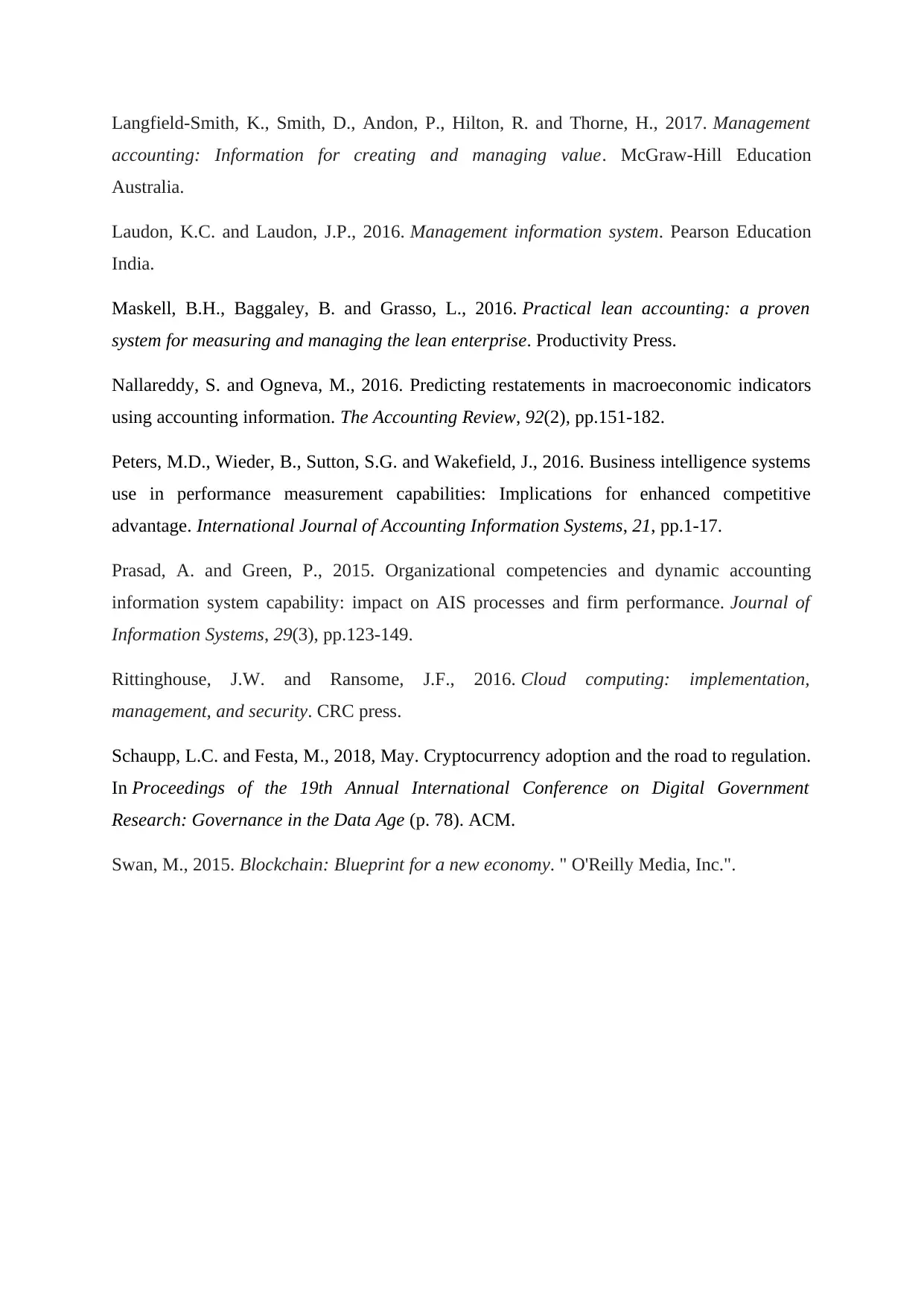
Langfield-Smith, K., Smith, D., Andon, P., Hilton, R. and Thorne, H., 2017. Management
accounting: Information for creating and managing value. McGraw-Hill Education
Australia.
Laudon, K.C. and Laudon, J.P., 2016. Management information system. Pearson Education
India.
Maskell, B.H., Baggaley, B. and Grasso, L., 2016. Practical lean accounting: a proven
system for measuring and managing the lean enterprise. Productivity Press.
Nallareddy, S. and Ogneva, M., 2016. Predicting restatements in macroeconomic indicators
using accounting information. The Accounting Review, 92(2), pp.151-182.
Peters, M.D., Wieder, B., Sutton, S.G. and Wakefield, J., 2016. Business intelligence systems
use in performance measurement capabilities: Implications for enhanced competitive
advantage. International Journal of Accounting Information Systems, 21, pp.1-17.
Prasad, A. and Green, P., 2015. Organizational competencies and dynamic accounting
information system capability: impact on AIS processes and firm performance. Journal of
Information Systems, 29(3), pp.123-149.
Rittinghouse, J.W. and Ransome, J.F., 2016. Cloud computing: implementation,
management, and security. CRC press.
Schaupp, L.C. and Festa, M., 2018, May. Cryptocurrency adoption and the road to regulation.
In Proceedings of the 19th Annual International Conference on Digital Government
Research: Governance in the Data Age (p. 78). ACM.
Swan, M., 2015. Blockchain: Blueprint for a new economy. " O'Reilly Media, Inc.".
accounting: Information for creating and managing value. McGraw-Hill Education
Australia.
Laudon, K.C. and Laudon, J.P., 2016. Management information system. Pearson Education
India.
Maskell, B.H., Baggaley, B. and Grasso, L., 2016. Practical lean accounting: a proven
system for measuring and managing the lean enterprise. Productivity Press.
Nallareddy, S. and Ogneva, M., 2016. Predicting restatements in macroeconomic indicators
using accounting information. The Accounting Review, 92(2), pp.151-182.
Peters, M.D., Wieder, B., Sutton, S.G. and Wakefield, J., 2016. Business intelligence systems
use in performance measurement capabilities: Implications for enhanced competitive
advantage. International Journal of Accounting Information Systems, 21, pp.1-17.
Prasad, A. and Green, P., 2015. Organizational competencies and dynamic accounting
information system capability: impact on AIS processes and firm performance. Journal of
Information Systems, 29(3), pp.123-149.
Rittinghouse, J.W. and Ransome, J.F., 2016. Cloud computing: implementation,
management, and security. CRC press.
Schaupp, L.C. and Festa, M., 2018, May. Cryptocurrency adoption and the road to regulation.
In Proceedings of the 19th Annual International Conference on Digital Government
Research: Governance in the Data Age (p. 78). ACM.
Swan, M., 2015. Blockchain: Blueprint for a new economy. " O'Reilly Media, Inc.".
1 out of 10
Related Documents
Your All-in-One AI-Powered Toolkit for Academic Success.
+13062052269
info@desklib.com
Available 24*7 on WhatsApp / Email
![[object Object]](/_next/static/media/star-bottom.7253800d.svg)
Unlock your academic potential
© 2024 | Zucol Services PVT LTD | All rights reserved.



